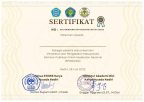THE EFFECT OF KETAWA BISU METHOD ON THE ABILITY OF STROKE EARLY DETECTION IN FAMILY WITH HYPERTENSION
Keywords:
Ketawa Bisu, Early Detection, StrokeAbstract
The ability to early detection of stroke in the community is still lacking, causing delays in stroke treatment. This is related to hypertension which is a risk factor for stroke 6 times higher. The intervention given to improve early detection ability is FAST detection which is applied in Indonesian to Ketawa Bisu. The purpose of the study was to determine the effect of the Mute Laughter method on the ability of early detection of stroke in families with hypertension. Research design Quasi-experimental (Pretest and Posttest Control Group Design). The population is 62 and the sample size is 32 respondents, which are divided into 16 intervention groups and 16 controls using random sampling. Data were analyzed using the Wilcoxon dan Mann Whitney test. The results of the Wilcoxon test showed that Ketawa Bisu had an effect on the early detection ability of stroke in the intervention group (p-value – 0,000) and there was no effect on the control group (p-value = 0,317). The results of the Mann-Whitney test showed that there was a difference in the effect of early detection of stroke in the intervention and control groups (p-value – 0,000). The Ketawa Bisu affects the respondent’s ability because it is in the form of acronyms or abbreviations that are easy to remember, and understand, and clear picture instructions to distinguish between normal and abnormal patients with signs of stroke symptoms. Therefore, as an alternative way of early detection to prevent delays in stroke treatment, it is recommended that people use the Ketawa Bisu method.
Downloads
Published
Issue
Section
License
Copyright (c) 2022 Seminar Publikasi Ilmiah Kesehatan Nasional

This work is licensed under a Creative Commons Attribution 4.0 International License.







